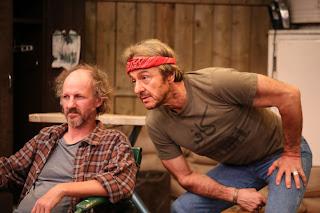This
play takes place in a psychiatric hospital, a fact that some young people may find
confusing. In the 55 years since this play first appeared, the United States
began closing down such hospitals, preferring to see potential mental patients
enter the field of politics. How’s that working out for us?
Ken
Kesey’s novel was a screech against a repressive society that tried to grind
down anyone who was a non-conformist. But the subtext deals with how we have
all been tranquilized and at times euthanized into submission, as we are
maneuvered over and over again into waging war against other countries and at
times against ourselves. I will leave it to you to make the obvious connections
to our world today.
As
for the play itself, written by Dale Wasserman, it feels a bit dated.
Electrochock therapy—which is administered to the rebellious Randall P.
McMurphy—was seen back then as the most gothic torture imaginable (and it is
rendered that way in Aaron Benson’s impressive scenic design). But since then,
there have been more positive analyses of that particular therapeutic approach.
The
male ward of this “loony bin” is filled with a bundle of characters that are
all distinctive in their mental difficulties, and they are performed with
admirable precision by the cast under the direction of William Roudebush. Those
who are particularly effective are George Roth as the closeted and erudite Dale
Harding, Jeremy Gladen as twitchy and mommy-dominated Billy Bibbit, and Tony
Zanoni as impulsive Martini. Benjamin Gregorio also turns in a haunting
performance as the virtually silent and lobotomized Ruckly.
In
the challenging, showpiece role of McMurphy, Bryant Carroll has all the feints
and twitches of this larger-than-life character down pat. But those details
never truly coalesce into a character that insistently worms his way into his
fellow patients’ hearts, and ours.
As
a sane man who thought he was putting one over on the system by pretending to
be mentally challenged, thereby avoiding hard time on a chain gang, McMurphy
should be someone with whom we can all relate. But too often, Carroll relies on
a manic laugh and a swaggering strut instead of establishing strong threads of
connection between McMurphy and the others.
As
his main tormentor Nurse Ratched, Katie DeBoer masterfully commands her charges
with a virtually unchanging icy smile/stare that could drop a charging rhino to
its knees. But in a similar way to Carroll’s McMurphy, this interpretation of
the “big nurse” never goes beyond that splendidly played single note, and never
shows a woman with more dimensions. By making her a bit more human, it would
actually increase the horror of the situation.
In
all, this Cuckoo’s Nest captures many
of the aspects of Kesey’s book and Wasserman’s adaptation. But it doesn’t soar
quite high enough to momentarily liberate us all from the cages in which we
find ourselves.
One
Flew Over the Cuckoo’s Nest
Through
October 8 at the Beck Center, 17801 Detroit Ave., Lakewood, 216-521-2540,
beckcenter.org




